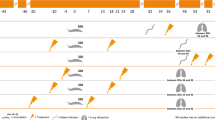Abstract
The objective of the present study was to evaluate the efficacy and safety of the antiparasitic spot-on formulation containing emodepside 2.1 %/praziquantel 8.6% (Profender®, Bayer) in the treatment of natural feline infection with the lungworm Aelurostrongylus abstrusus (Nematoda, Strongylida). Efficacy of Profender® given once at the licensed dose was tested in comparison to a control oral formulation containing fenbendazole 18.75 % (Panacur®, Intervet) given over three consecutive days at the licensed dose. Efficacy assessment was based on larvae per gramme of faeces (LPG) counts, measured on days 28 ± 2 following treatment and compared to counts on days –6 to –2. In total 24 cats treated either with Profender® (n = 12) or with Panacur (n = 12) were included in the assessment of efficacy and safety. Mean LPG post-baseline counts (days 28 ± 2) were 1.3 LPG for both Profender® and Panacur®, demonstrating similar efficacy of 99.38 % for Profender® and 99.29 % for the control product. No treated animals showed adverse events. This trial demonstrated that both Profender® spot-on formulation and oral paste Panacur® are safe and effective in the treatment of aelurotrongylosis in cats. Future practical perspectives in feline medicine and the major advantages of the spot-on product compared to the oral paste are discussed.
Similar content being viewed by others
References
Barrs VR, Swinney GR, Martin P, Nicoll RG (1999) Concurrent Aelurostrongylus abstrusus infection and salmonellosis in a kitten. Aust Vet J 77:229–232
Blagburn BL, Hendrix CM, Lindsay DS, Vaughan JL (1987) Anthelmintic efficacy of ivermectin in naturally parasitized cats. Am J Vet Res 48:670–672
Clayton HM (1983) The management and treatment of respiratory nematode infections in small animals. Vet Ann 23:254–259
Euzeby J (1981) La coprologie chez les carnivores. In: Diagnostic expérimental des helminthoses animales. Travaux pratiques d’helminthologie vétérinaire, Livre 1, Informations Techniques des Services Vétérinaires, Paris, France.
Grandi G, Calvi LE, Venco L, Paratici C, Genchi C, Memmi D, Kramer LH (2005) Aelurostrongylus abstrusus (cat lungworm) infection in five cats from Italy. Vet Parasitol 134:177–182
Hamilton JM, Weatherley A, Chapman AJ (1984) Treatment of lungworm disease in the cat with fenbendazole. Vet Rec 114:40–41
Harder A, von Samson-Himmelstjerna G (2002) Cyclooctadepsipeptides–a new class of anthelmintically active compounds. Parasitol Res 88:481–488
Kirkpatrick CE, Megella C (1987) Use of ivermectin in treatment of Aelurostrongylus abstrusus and Toxocara cati infection in a cat. J Am Vet Med Assoc 190:1309–1310
Lewis DT, Merchant SR, Neer TM (1994) Ivermectin toxicosis in a kitten. J Am Vet Med Assoc 205:584
Miller BH, Roudebush P, Nard HG (1984) Pleural effusion as a sequel to aelurostrongylosis in a cat. J Am Vet Med Assoc 185:556–557
Roberson EL, Burke TM (1980) Evaluation of granulated fenbendazole (22.2%) against induced and naturally occurring helminth infections in cats. Am J Vet Res 41:1499–1502
Schmid K, Duewel D (1990) Use of fenbendazole (Panacur® tablets ad. us. vet.) against helminth infections in cats. Tieraerztl Umsch 45:873–875
Scott DW (1972) Current knowledge of Aelurostrongylus abstrusus in the cat. Cornell Vet 63:483–500
Sloss MW, Kemp RL, Zajac AM (1994) Fecal examination: dogs and cats. In: Veterinary Clinical Parasitology, 6th edn., Iowa State University Press, Ames, USA.
Traversa D, Guglielmini C (2008) Feline aelurostrongylosis and canine angiostrongylosis: a challenging diagnosis for two emerging verminous pneumonia infections. Vet Parasitol 157:163–174
Traversa D, Di Cesare A, Milillo P, Lohr B, Iorio R, Pampurini F, Schaper R, Paoletti B, Heine J (2009) Efficacy and safety of imidacloprid 10 % / moxidectin 1 % spot-on formulation in the treatment of feline aelurostrongylosis. Parasitol Res 105(1):S55–S62
VICH guideline 9: Good clinical practice. Veterinary International Cooperation on Harmonization, European Agency for the Evaluation of Medicinal Products, London, July 2000.
VICH guideline 19: Efficacy of anthelmintics: specific recommendations for canine. Veterinary International Cooperation on Harmonization, European Agency for the Evaluation of Medicinal Products, London, July 2001.
Author information
Authors and Affiliations
Corresponding author
Rights and permissions
About this article
Cite this article
Traversa, D., Milillo, P., Di Cesare, A. et al. Efficacy and Safety of Emodepside 2.1 %/Praziquantel 8.6% Spot-on Formulation in the Treatment of Feline Aelurostrongylosis. Parasitol Res 105 (Suppl 1), 83–90 (2009). https://doi.org/10.1007/s00436-009-1499-5
Published:
Issue Date:
DOI: https://doi.org/10.1007/s00436-009-1499-5




